ddanbe has provided two great examples of reading the Excel sheets. And This Link directly from IBM shows you how to parse a DataTable into DB2 it's in C# but easy enough to translate.
Job Done =0)
ddanbe has provided two great examples of reading the Excel sheets. And This Link directly from IBM shows you how to parse a DataTable into DB2 it's in C# but easy enough to translate.
Job Done =0)
Thanks Diafol. Just what I needed to know.
Hey guys. I'm writing myself an online toolbox (for my code snippets). I have a "Snippets" table. My question is this. Would you save the snippet source in a Text column or would you have the snippet saved to a text file and the Snippet entry would reference the file name?
e.g. Snippets or Snippets2
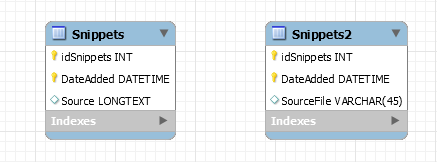
Could you not parse the spreadsheet via a DataTable first? SpreadSheet -> DataTable -> DB2
Using .Net's SHA1 Crypto Service to compare hashes between a user's password and their stored hashed password.
Simplez =0)
Are the colours of the object solid? If so maybe you could check the point under the mouse. Other wise it'd be a mathmatical hit test.
So am I right in assuming, you preferance is:
or even
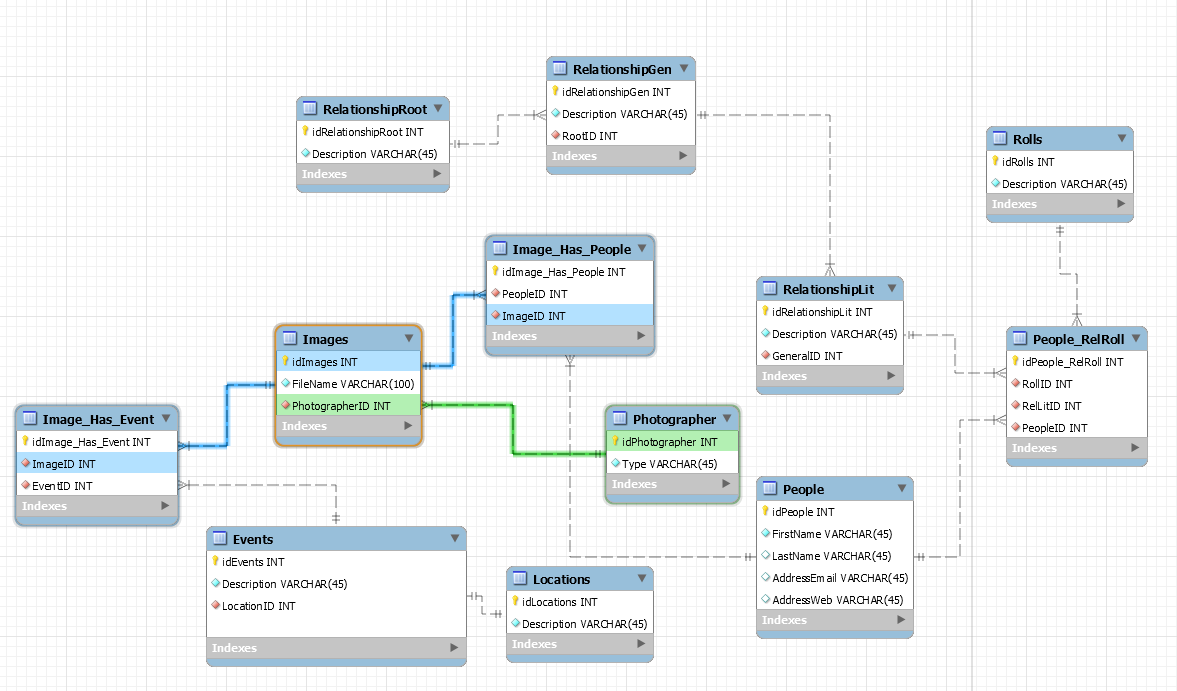
In the above model I have an Images table which holds all the filenames relevant to the image. I have two relationship tables (Image_Has_People and Image_Has_Event). Both of these tables have an FK ImageID linked to the Image table's PK idImage. I'm wondering, if I set both relationship table's ImageID FK to On Delete Cascade, If I delete an entry in one of the relationship tables will that not also delete the image table entry too?
What would I need to do in order that when I delete an Image entry from the Image table it also removes relevant entries in the two relational tables but not vice-versa?
I'm really confused by this, by Short do you mean sort, and if you mean sort, can't you just do this
Dim iVals As Integer() = {1, 9, 3, 10, 6, 2, 8, 5, 7, 4}
Array.Sort(iVals)
If you wanted to reverse the sort order
Public Class ReverseComparer : Implements IComparer
Function Compare(x As Object, y As Object) As Integer _
Implements IComparer.Compare
Return New CaseInsensitiveComparer().Compare(y, x)
End Function
End Class
'Button Click Event
Dim RC As New ReverseComparer
Dim iVals As Integer() = {1, 9, 3, 6, 2, 10, 15}
Array.Sort(iVals, RC)
Display the results
For Each Val As Integer In iVals
Console.WriteLine(Val)
Next
I think The tables may be missleading. The Album Table is the main table which will be queried when looking for photos eg
SELECT idPhoto FROM Album WHERE idEvent = 8 (First Dance)
then to get people tagged
Select idPhoto, idPeople From Tags Where idRoll = 4 (Bridesmaid)
I then think id do the JOIN INNER thing with these two tables to get images of only the bridesmaid at the first dance?
Is the category table you talk of not my "Event Table" in the model?
The crosswalk bit (I'm not sure what that is) but is it something like:
idPhoto idTag
9 1
9 2
9 3
9 4
9 5
9 6
9 7
Hi guys, I'm currently on the pretty cool Database development path. I've quickly got to terms with basic SQL with individual tables, and various queries. Now things seen to be getting a little beyond a concept I had been taught from a young age.
Am I doing this right. The images are in Excel for display purposes but this reflects my modal.
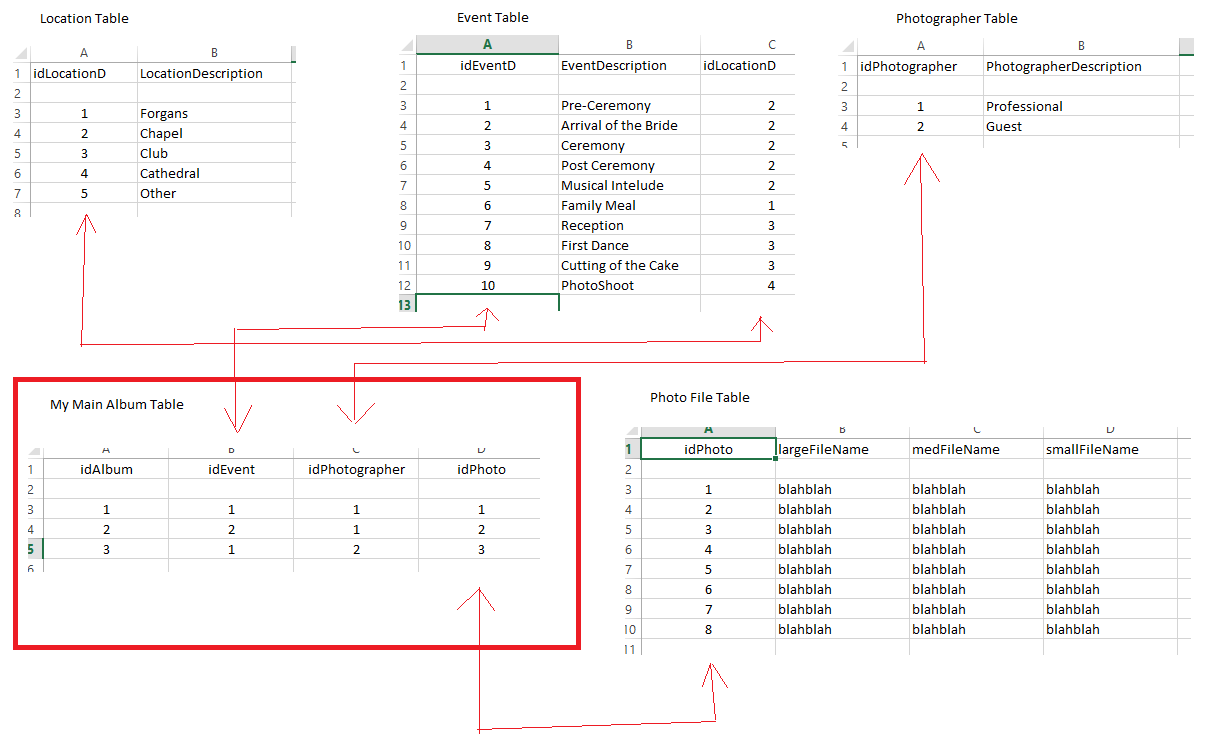
I then have a tables which holds data like who the subjects are and who the focal subject is
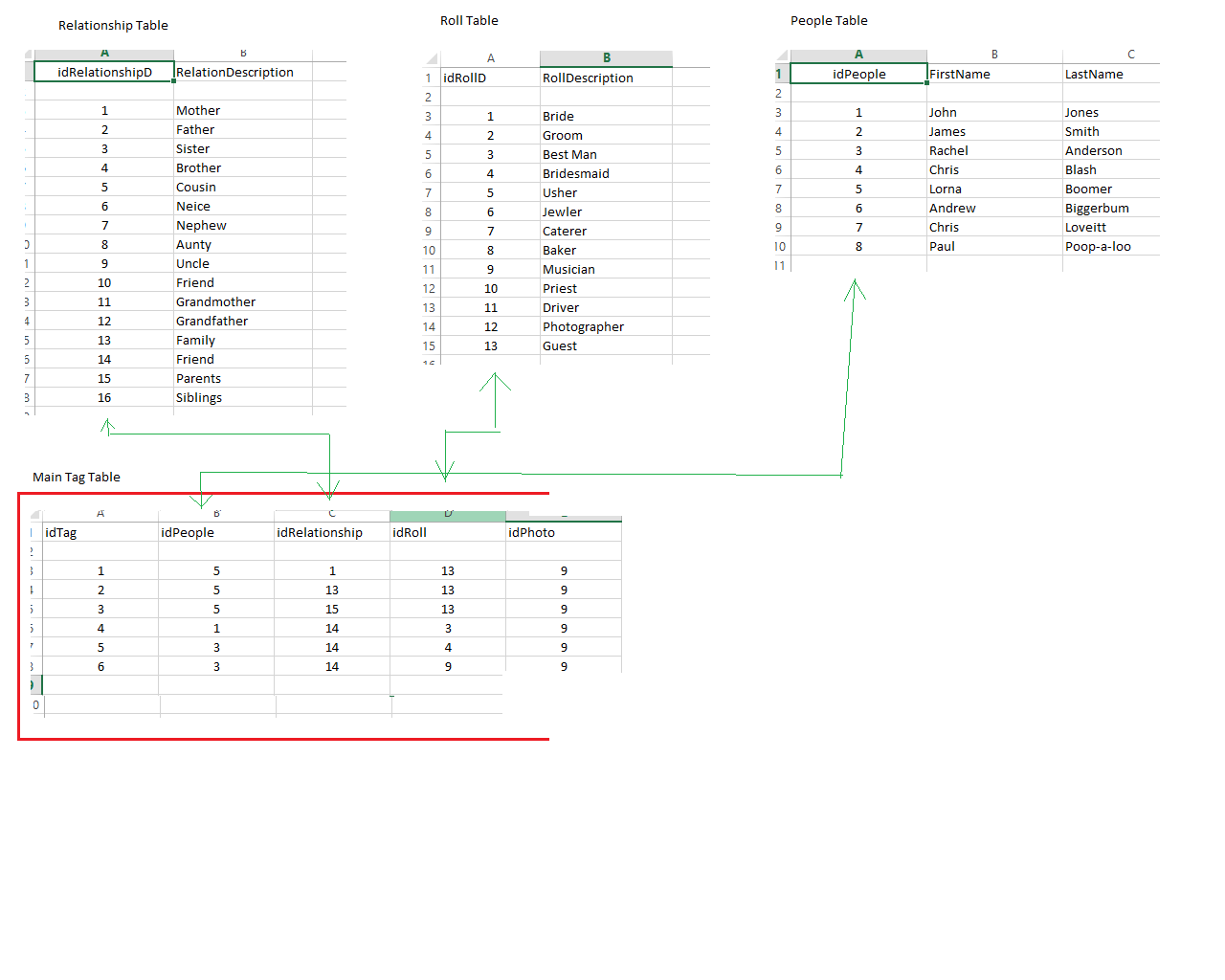
However in this TagTable I am repeating entries eg. idPeople 3 (Rachel) she is a bridesmaid and a musician, so she has two entries. idPeople 5 (Lorna) has three entries because i've classed them as Mother, PArent and family. Not only that, all these entries are for one photo (idPhoto9)
lets say, I want a table with the bridesmaid at the firstdance. would my query be something like a JOIN INNER to compare results from the TAG table and ALBUM table. What I think I do is get a results table which consits of all images including the Bridesmaid, I then query that results table with a JOIN INNER query against the ALBUM table to return results that only have the bridesmaid in the first dance event?
Now I want to return all photos at location Chapel. …
This wee snippet is for inspiration not solution. Planting the seed of solution can often be more effective than providing a solution its self dont you think
I was just mucking around with a progress feature for some software, and thought I'd just put this wee demo up of a clocky type progress thing =0)
Just Copy and paste the form code and watch it run. (p.s it's in degrees, note minutes and seconds)
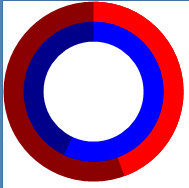
My Pleaseure.
If thae parsing fails, you wont have any results so trying to access MyResults.Results(0) will "result" in an error as a result object hasn't been added to the results list.
Ok, the first part of the structure is ok, so here's the Geometry bit:
The Complete Code Is At The End
In geometry you have a few properties, let's make a simple textified version:
-bounds
--northeast
---lat
---lng
--southwest
---lat
---lng
-location
--lat
--lng
-location_type
-viewport
--northeast
---lat
---lng
--southwest
---lat
---lng
From the above structure you can see there are a couple of properties, some of which the structure is repeated. so the base structure for geometry would have the following properties
bounds
location
location_type
viewport
viewport and bounds have the same sub properties
northeast
southwest
and those sub properties, as well as location have sub properties
lat
lng
so create a LatLong Object
Public Class LatLong
Public Property lat As String
Public Property lng As String
End Class
New we'll create a Coords object for northeast, southwest
Public Class Coords
Public Property northeast As LatLong
Public Property southwest As LatLong
End Class
and the actual GeometryData object
Public Class GeometryData
Public Property bounds As Coords
Public Property location As LatLong
Public Property location_type As String
Public Property viewport As Coords
End Class
So your complete structure now looks like this
Public Class MyResults
Public Sub New()
results = New List(Of Result)
End Sub
Public Property results As List(Of Result)
Public Property status As String
End Class
Public Class Result
Public Sub New()
address_components = New List(Of AddressComponents)
types = …Of course you can. Am I right in assuming that you've got a good idea of what's going on, you're just having difficulty in matching the structure? I'll keep my eyes on this thread and have a look into this whilst waiti9ng for your response.
Just out of interest, do you have your current effort available to post so I can also see if you're not to far away from your solution?
BAre with me, I'll have a play in the mean time.
Note: The calculation at line 16 rounds to the nearest integer (up or down). assuming you are going to allow rounding up (Not very business minded I know), you may want to replace line 16 with the following code
'If the Minute value is > 95% then increase the hour by 1
If CInt((10 / 60) * Diff.Minutes) > 9 Then
Return Diff.Hours + 1
Else
Return Diff.Hours & "." & CInt((10 / 60) * Diff.Minutes)
End If
Oherwise if you are business minded replace line 16 with the following to always ROUND DOWN to the nearest 10%
Return Diff.Hours & "." & (CInt((100 / 60) * Diff.Minutes)) \ 10
If you're going to point out the difference between VB6 and VB.Net, it may be useful to provide some useful methods provided by .Net. This simple function using Date,Time and TimeSpan will return the hours worked and minutes in 1\10 intervals.
Private Sub Button1_Click(sender As Object, e As EventArgs) Handles Button1.Click
Console.WriteLine(CalculateDailyHours("29/10/2014 17:00", "30/10/2014 03:12"))
End Sub
'Make the returned value a double so it can easily be used for future calculations
Private Function CalculateDailyHours(StartValue As String, EndValue As String) As Double
Dim StartTime As DateTime = BuildDateTime(StartValue)
Dim EndTime As DateTime = BuildDateTime(EndValue)
Dim Diff As TimeSpan = EndTime - StartTime
'Get The Hour Difference and The Minute Difference in intervals of 10%
Return Diff.Hours & "." & CInt((10 / 60) * Diff.Minutes)
End Function
Private Function BuildDateTime(DTValue As String) As DateTime
Dim vDate As Date = DTValue
Return New DateTime(vDate.Year, vDate.Month, vDate.Day, vDate.Hour, vDate.Minute, 0)
End Function
The returned value is 10.2 as a double
After trying to manipulate PNG files and failing miserably discovering that the standard GDI doesn't provide support for any PNG parameters decided to provide some basic image manipulation functions built into .Net that I came across on my investigations.
1. Adjust Image Quality
2. Flip Image Horizontally
3. Flip Image Vertically
4. Rotate Image (90 Degree Step)
This Source Uses 4 buttons, A HScrollBar and A PictureBox.
You're welcome. I hoped it's helped.
-------
Looking at your provided JSON string it looks like the property name is long_name >"long_name" : "Sunderland"
for example, if you set your structure up correctly you would access it by the following
Dim Town as string = MyResults.results(0).address_components(1).long_name
If you have trouble with this I will be happy to provide you with further assistance.
to get you started you would begin with the follwoing structure
Your base class may look something like this:
Private class MyResults
Public Sub New()
results = New List(Of Result)
End Sub
Public property results As List(Of Result)
Public property status As String
End Class
Your Result class may look like this
Private Class Result
Public Sub New()
address_components = New List(Of AddressComponents)
types = New List(Of String)
geometry = New GeometryData
End Sub
Public property address_components As List(Of AddressComponents)
Public property formatted_address As String
Public property geometry As GemoetryData
Public property partial_match As Boolean
Public property types As List(Of String)
End Class
Your AddressComponents object may look like this:
Private Class AddressComponents
Public Sub New()
types = New List(Of String)
End Sub
Public property long_name As String
Public property short_name As String
Public property types As List(Of String)
End Class
Do you see how you're building an object structure to match the structure of the JSON string. The geometry class would be a little more complicated, but the same principal.
Looking at your provided JSON string it looks like the property name is long_name >"long_name" : "Sunderland"
for example, if you set your structure up correctly you would access it by the following
Dim Town as string = results.address_components(1).long_name
If you have trouble with this I will be happy to provide you with further assistance.
to get you started you would begin with the follwoing structure
Your base class may look something like this:
Private class MyResults
Public results As List(Of Results)
Public status As String
End Class
Private Class Results
Public address_components As List(Of AddressComponents)
Public formatted_address As String
Public geometry As objGemoetry
End Class
Your AddressComponent object may look like this:
Private Class AddressComponents
Public long_name As String
Public short_name As String
Public types As List(Of String)
End Class
Do you see how you're building an object structure to match the structure of the JSON string. The geometry class would be a little more complicated, but the same principal.
BlowFish was the brain child of Bruce Schneier back in 93. Since BlowFish was released to the public domain, Bruce Schneier has released new encryption algorythems, TwoFish and ThreeFish. BlowFish is an increddibly popular and very strong algorythem. Because it conforms to Kerckhoffs's Principal Explained Here, even though the algorithem is public domain, it still isn't crackable without the key.
I'm far from a maths genius, far, far from it. My only involvement in this class is converting from VB6 and wrapping. I have tried to comment the parts of the algorithm that I understand, much beyond that I'm afraid you'll probably have a better understanding than I.
I have wrapped the class up nicely so there is little more then Encode, Decode and Key available to the user. I have also included as much error handling as possible.
There are many, many examples of BlowFish out there, in all kinds of languages, but not VB.Net. With that in mind, I decided to share this conversion so there is at least one VB.Net version out there... And where best to host it, but on DaniWeb. Obviousley in accordance to the aforementiond Kerckhoffs's principal, I'm not jeopardizing the security of this algorythem, however it may be worth playing around with the intialization values to ensure your Boxes are unique.
The code provided is a guide how you can use the Class. Very simple.
Jay
I just don't get this one Jim, apart from a whole bunch of un-needed code... batoolhussain's, yours, and even:
Dim pic As Bitmap = New Bitmap(PictureBox1.Image)
Dim gray = New Bitmap(pic.Width, pic.Height)
For x As Integer = 0 To (pic.Width) - 1
For y As Integer = 0 To (pic.Height) - 1
Dim c As Color = pic.GetPixel(x, y)
Dim d As Integer = (CInt(c.R) + CInt(c.G) + CInt(c.B)) \ 3
gray.SetPixel(x, y, Color.FromArgb(d, d, d))
Next
Next
PictureBox2.Image = gray
Should all work. I can only assume there's a dodgy property somewhere?
There is no reason why this code shouldn't work. To speed things up a little move PictureBox2.Image = gray outside of the two for-next loops.
try creating a new form, with a picturebox (Change no properties) and the button. place the code in the button and load an image into the picture box's image property and try running again.
I've just copied and pasted your code into the above scenario and it works.
Though instead of typing out all those properties like that just for a couple of bits of data you may just want to structure your properties like this
Public Property bytes As Long
Public Property is_dir As Boolean
etc
Note The property name and the object structure has to match the JSON names and structure.
Have you tried parsing the JSON into an object structurte? here is a JSON string from a DropBox list files Query:
{"hash": "2e50103f8605f7639f7da0fd2e934fe4", "thumb_exists": false, "bytes": 0, "path": "/", "is_dir": true, "icon": "folder", "root": "app_folder", "contents": [{"rev": "5929d57df1", "thumb_exists": true, "path": "/flower.jpg", "is_dir": false, "client_mtime": "Mon, 15 Sep 2014 19:20:02 +0000", "icon": "page_white_picture", "bytes": 879395, "modified": "Mon, 15 Sep 2014 19:20:01 +0000", "size": "858.8 KB", "root": "app_folder", "mime_type": "image/jpeg", "revision": 89}, {"rev": "829d57df1", "thumb_exists": false, "path": "/test.xlsx", "is_dir": false, "client_mtime": "Mon, 08 Sep 2014 12:50:47 +0000", "icon": "page_white_excel", "bytes": 21699, "modified": "Mon, 08 Sep 2014 12:50:47 +0000", "size": "21.2 KB", "root": "app_folder", "mime_type": "application/vnd.openxmlformats-officedocument.spreadsheetml.sheet", "revision": 8}], "size": "0 bytes"}
A bit of a mess like this. However once you've determind the structure you can create an object structure like this
Public Class dbFiles
Private _contents As List(Of dbFile)
Public Property contents As List(Of dbFile)
Get
Return _contents
End Get
Set(value As List(Of dbFile))
_contents = value
End Set
End Property
Private _hash As String
Public Property hash As String
Get
Return _hash
End Get
Set(value As String)
_hash = value
End Set
End Property
Private _thumb_exists As Boolean
Public Property thumb_exists As Boolean
Get
Return _thumb_exists
End Get
Set(value As Boolean)
_thumb_exists = value
End Set
End Property
Private _bytes As Long
Public Property bytes As Long
Get
Return _bytes
End Get
Set(value As Long)
_bytes = value
End Set
End Property
Private _is_dir As Boolean
Public Property is_dir As Boolean
Get
Return _is_dir
End Get …I almost forgot to mention LINQ too... really cool, powerful stuff. This is amazing, you can query XML, SQL, Object Structures, Lists, Collections etc Click Here
I've just gone through all this myself. It was great. Here were my steps for my particular approach. (Links Below) Note: This was just my recent research into MySQL, there are other alternatives.
First there are a few DBMS or RDBMS <--- Learned that too. MySQL Workbench, MS SQL Server, Oracle etc
I chose to Use MySQL, so I downloaded SQL Server which runs nicely as a service in the background. I also have MySQL Server running on my server (For remote testing) and installed MySQL Workbench for additional testing and development.
I then downloaded and installed SQL Connector for VB.Net, which lets me easily connect to MySQL databases.
After that I bought a SQL book which gave me all the commands I need to play with.
I then checked out Microsoft's Virtual Accadamy on database fundamentals
I'm Having great fun.
Watched and learned the fundamentals of databases on MSVA Click Here These guys are using MS SQL Server (T-SQL etc) which has some slight SQL variations
Bought this book for SQL commands (Superb by the way) Click Here
I then got my hannds on MySQL Server This page gives you links to MySQL, MySQL Workbench, and the VB.Net Connectors Click Here
It took a couple of days to figure everything out, but now it's all fine and dandy.
Note: if you don't want to have to install the MySQL Server then you need to …
Did you know that you can data bind a bitmap to a PictureBox's image property, and the source image doesn't have to be in a binary format stored in a data table?
Using a standard object setup for data binding (iNotify etc.) you can easily update your program's image propertie's from one place.
I love this stuff, brings back the good old days. It's not even a "Complete Game" still I spent a good five minutes pinging balls all over the place.
Ok, that's good...
Then it's you that's doing something wrong.
Download the solution below, it is the same code in action. I have modified it slightly to ensure the pan doesnt go beyond the boundries of the image.
I have to stress though, panning and zooming an image this way just isn't cool beans, however... it seems to be a popular aproach by... people.
is your picturebox inside a panel?
I'm assuming... oddly once again you just want to pan the picturebox inside your panel, using the panel as a clipping device... Here, this is the panning code you need.
Private mDown As Boolean = False
Private oPoint As Point = Nothing
Private offPoint As Point = Nothing
Private Sub PictureBox1_MouseDown(sender As Object, e As MouseEventArgs)
Handles PictureBox1.MouseDown
If mDown = False Then
mDown = True
oPoint = New Point(Cursor.Position.X - (Panel1.Left + Me.Left),
Cursor.Position.Y - (Panel1.Top + Me.Top))
offPoint = New Point(PictureBox1.Left, PictureBox1.Top)
End If
End Sub
Private Sub PictureBox1_MouseMove(sender As Object, e As MouseEventArgs)
Handles PictureBox1.MouseMove
If mDown = True Then
PictureBox1.Left = offPoint.X - (oPoint.X - (Cursor.Position.X -
(Panel1.Left + Me.Left)))
PictureBox1.Top = offPoint.Y - (oPoint.Y - (Cursor.Position.Y -
(Panel1.Top + Me.Top)))
End If
End Sub
Brilliant. Thanks.
Two more books I need to pur-chase dang it!
One last question based on these two technologies, is there anything I need to be aware of server-side-requirents wise?
Fortunately this is not a projdect I'm starting anytime soon, this is me preparing myself for said future project\requirement.
Would you be able to provide a one sentance description of what WCF and ASP.NET does\is and what their roles are.
Basically a dummy description if you will for my brain to latch onto.
Hi WebDev Guys,
Ok, I have a very general question as the title suggests. I am very much a back-end developer and have only dabbled in web development. I would consider myself a total ammature when it comes to Web Development though am confident after playing with PHP, JavaScript, JQuery, HTML5 and CSS3 and with my Android\VB.Net and Java ecxperience should be able to get a grasp of things behind the scenes quite happily.
This is where I'm at at the moment A Simple Demo I think I've figured out how to use Divs and basic CSS3 but am now looking for direction in the following fields. (Note: My front end design skills are appauling with any technology, server or client)
I'm not looking for source guys, just direction in what technologies you think I need to persue in order to achieve the following.
I don't know where to start? I'm going to throw some words around in hope you guys will know better then I, what I'm actually talking about.
One Database online, Two Access Methods
Web Access
The user can login, manage settings, preferences, account information etc online
PC Software Access
There can be a "back-office" PC\Android based piece of software which can access this database. Even a user based pieve of software which let's them access their data from the sever database.
What I seem to be missing is the technology (ideally a single one ASP.NET?) that links Web-Server Database-PC …
Where's Walley Easy:
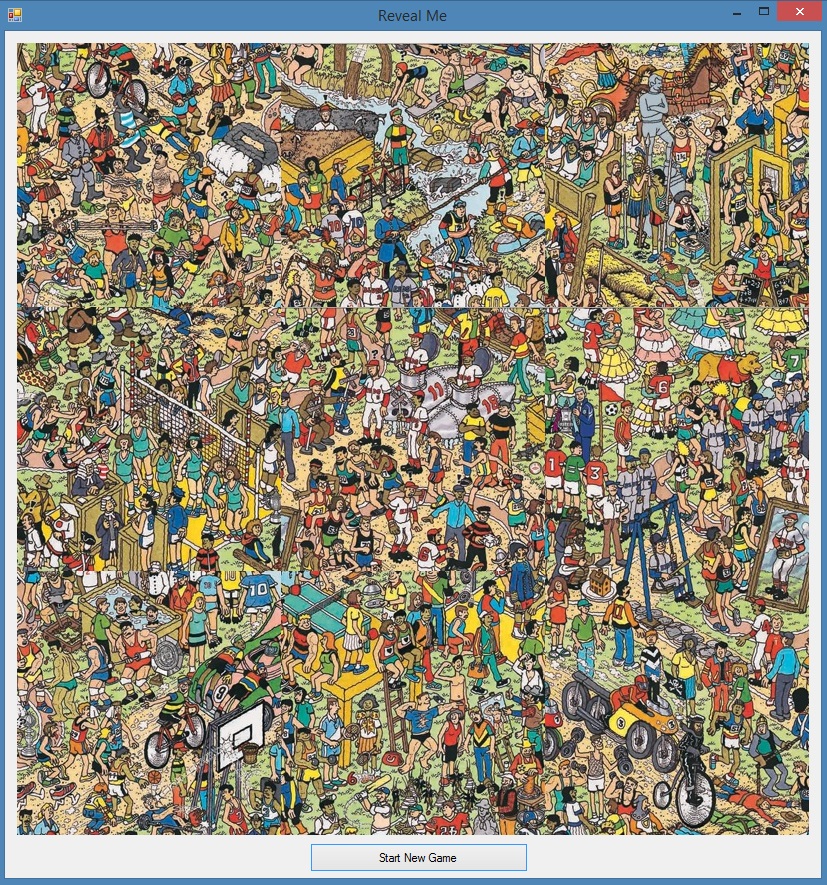
Where's Walley Medium: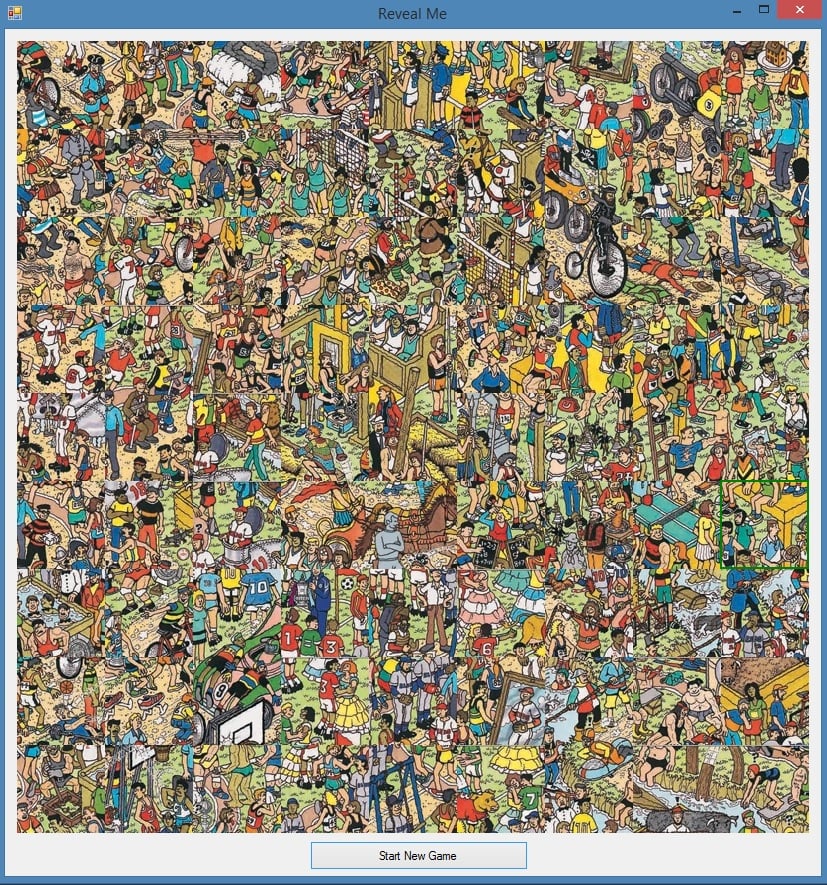
NOTE: The games GUI is not fully implemented, so changing it's image and difficulty is done manually in the Button.Click Event
NOTE: Whether you download the VS2013 source file or copy and paste the code, you need to download, and extract the two image files to the project's "Bin\Debug" directory.
If you copy and paste the source ensure your form has the following controls:
Button (Button1)
PictureBox (Name:pbGameBoard, Width:792, Height:792)
This is a fun example using graphics. It is a representation of the classic tile slide game, where you slide the tiles around to make the picture. This version is a little different. There are Tiles and Sub Tiles. The Tile Grid is 9 x 9. Each Tile has a 9 x 9 Sub Tile Grid.
If you set the game to Easy then only the main Tiles are scrambled. If it is set to Medium then not only are the Tiles scrambled but so are their sub tiles.
Instead of sliding the tiles around, this game is actually switching tiles\subtiles with the adjacent tile\subtile. Subtiles cannot be switched with subtiles from a different tile.
To Start A New Game:
Click your button
To Move Tiles:
Select the center SubTile of The Tile you want to move. The SubTile will be selected in Green. Move the mouse to the center SubTile of an adjacent tile and the cursor will turn yellow. If you click now, the two Tiles will be switched.
Image …
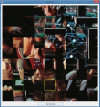
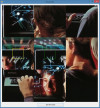
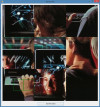
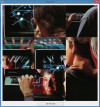
Take Heed
There are lots of things to be aware of with the Windows Registry. In most cases the best thing to be aware of is that ideally you should avoid playing with it at all costs. Alas, we are what we are and we do what we do. My advice to you is to make a back up of your registry. Remember though, values are read and written continuousley without our knowledge, and reverting to a backup made 10 minutes ago may not reflect your current systems settings so be careful.
Backup Your Registry
Start RegEdit, Search for RegEdit in either the run or search box in your system's start menu. Once you have opened RegEdit goto menu Start>Export. In the save dialog box you will see a group box titled "Export Range". Select the "All" radio, choose your destination and file name and hit export.
Using Visual Studio to Create Your Icon Association
If you would prefer a much safer option, use VS's Extension Manager. Properties>Publish>Options>File Association. The headings of each field reflect the const values in the source provided.
Using This Source (Assumes)
I have told this association to use the current project's executable Icon, so you need to set a default icon for your project. You can point to any .ico, .dll, .exe you wish, but remember that the referenced object needs to be available, in the same location on the users computer too.
In With the …
Your going to have to program the code logic based on the mouses x and y position. To get the relevent mapdata from the mouse position you would simply do MapData(Mouse.X\32,Mouse.Y\32) this will return what kind of tile the mouse is over.
Apart from writing the game for you that's pretty much it... and no I'm not writing the game for you =0)
please do not be lazy like this video... Live, Love Code.
Infact, the code is so simple I can post it here too. Extract the Zip file below and add it as a resource to your project then paste this code.
Public Class Form1
Dim MapData(19, 19) As String
'DOUBLE CLICK ON LEVEL1.LEVEL TO VIEW ITS CONTENTS
Private Sub Form1_Load(sender As Object, e As EventArgs) Handles MyBase.Load
'Because I've included a res file I've had to read this data, all you would
' do with a file is read it line by line and split each line with ","
'POPULATE MAP DATA FROM LEVELDATA (Level1.Level)
'Get The Resource File Text
Dim strLevelData As String = System.Text.Encoding.UTF8.GetString(My.Resources.Level1)
'Split The String By VBCRLF (This will get our rows (Like ReadLine)
Dim MapDat As String() = Strings.Split(strLevelData, vbCrLf)
Dim Tiles As String()
'(-2) because I think I did the map data file too large
For MapY As Integer = 0 To MapDat.Length - 2
'We Split Each Row\Line By The ,
Tiles = Strings.Split(MapDat(MapY), ",")
For MapX As Integer = 0 To 19
'populate The MapData element with the relevent Map Data
MapData(MapX, MapY) = Tiles(MapX)
Next
Next
DrawMap()
End Sub
Private Sub DrawMap()
'Create A board bitmap
Dim Board As Bitmap = New Bitmap(32 * 20, 32 * 20)
'And a graphics object
Dim G As Graphics = Graphics.FromImage(Board)
'Iterate through each value of your mapdata
For y = 0 To 19
For X = 0 To 19
'and draw the relevant image at the relevant x\y location
G.DrawImage(ImageList1.Images(CInt(MapData(X, y))), New Point(X …Here, Have a look at this. I still can't believe that example... the s***t that gets published on youtube.
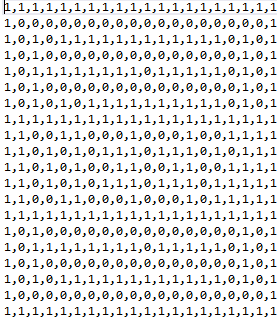
Becomes
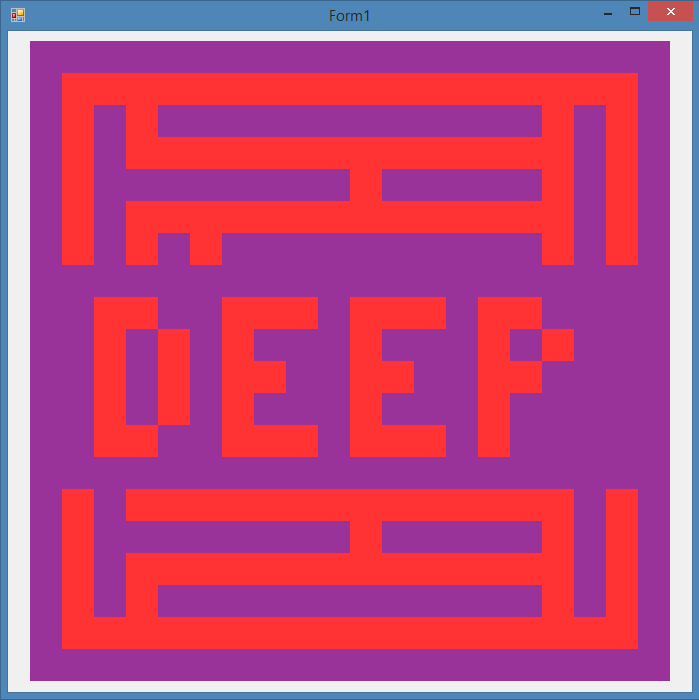
ok that guy is totally wrong DO NOT COPY THAT. I'll have the example for you in 5 mins.
I can't believe that video, it is such a bad way to do it.
the only reason I suggested this would be you could easily upload a new level to your server eg Level69.level. Your program could check for files it didn't already have. Assuming you kept the level file name in a specific format the game would know in which order the levels would increment eg(Level69 comes after Level68)
I can't resist, give me a second I'll build you an example.
I was only remembering the old days. I don't know how you've saved your map data, or what format it is.
However what I was demonstraighting above was. Imagine you have two square images let's say 32 pixels by 32 pixels. One image 1 is a wall tile, Image 0 is a floor tile. If you look at the "Array Data" abouve, and look closely it represents a very basic pac-man style maze you can follow the 0s round with your finger. When the program reads the test file, it draws the relevant tile based on the arrays location and value. It might look something like this
lets say the map tile area 100 by 100 and the tile images dimensions are 32x32. Lets imagine the map data is stored in an array (Like Above) MapData(100,100) and you have two images in an ImageList called MapTiles. MapTiles.Images(0) = Floor Tile, MapTiles.Images(1) = Wall Tile
Image You Have A Function That Draws A Tile called DrawTile(Image, XPosition, YPosition) which draws the image "Image" at position "XPosition", "Yposition"
for X = 0 to 99
For Y = 0 to 99
DrawTile(MapTiles.Images(MapData(X,Y)), X x 32, Y x 32)
Next
Next
you would now have a table\grid\map 3200pxls by 3200pxls where ever a 0 was in your array there would be a floor tile, wherever there was a one a wall tile
like I say this is ooooooold school 2d game development stuff.... when it was fun
(This isn't an answer, just reminising) I remember when I used to make oooooold games like packman etc (2d) the map data was stored in a simple 2d array. One of the easiest methods known to man. There were different arrays fo each level, one held floor\wall data, others held special event data, buttons, traps, teleports etc eg as basic as it get's 1=wall 0 = floor 6=teleport
1111111111111111111111111
1600000000000000000000001
1010111111111111111110101
1010000000000000000000101
1010011111110011111110101
1010010000000000000010101
1010010011110011110010101
1010010010000000010010101
1010000010000000010000101
1010010011111111110010101
1010010000000000000010101
1010011111111111111110101
1000000000000000000000061
1111111111111111111111111
Are those days really gone? boooooooooooo
each level was a simple text file called Level1.level, level2.level
I like it here Jim, there's some good characters.
Currently working on a generice company freeware title which I'm going to publish but post the source on here "Show off your projects". I think there's a bunch of useful snippet's which I think the community may like to use.